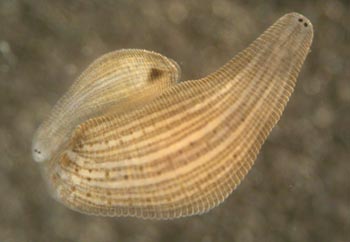

Why the Leech? Annelid Development and the Evolution of Developmental Mechanisms.
Leeches are regarded by some with a mixture of horror and disgust so intense as to preclude their consideration as objects for biological investigation. But in fact leeches are among the best studied representatives of the phylum Annelida (segmented worms). Glossiphoniid leech embryos in particular are quite beautiful and are well suited for cellular and molecular analyses of embryonic development using reverse genetic approaches.
Development and Evolution
One of the most fascinating and fundamental questions in biology is the essentially historical one of how the remarkable diversity of living species has evolved. For multicellular animals, the immediate causes of divergence in body plans must be changes in developmental processes between the various evolutionary lineages emanating from the last common ancestor.
Developmental studies and whole genome sequence comparisons indicate that these developmental changes result more from changes in the deployment and regulation of evolutionarily well-conserved developmental regulatory genes and signaling pathways, than from the appearance of new genes or pathways. Thus, to understand the developmental bases of evolutionary change, we must understand the development of extant species and then make comparisons, interpreting similarities and differences in light of the phylogenetic tree by which these extant species diverged.

To avoid bias, the phylogenetic tree should be constructed without making reference to any developmentaly derived traits (i.e., nothing about the morphology of the different taxa). This is important because, if we did, we would be building in assumptions about the very evolutionary changes we’re trying to understand—an example of circular reasoning. Molecular phylogenies provide the required "developmentally neutral" approach to constructing phylogenetic trees, and this approach has led to the re-organization of bilaterally symmetric animals into three major groups: Ecdysozoa (including arthropods, nematodes and other cuticle-shedding groups), Lophotrochozoa (including annelids, mollusks and related phyla), and Deuterostomia (including echinoderms, hemichordates and chordates) (phylogenetic tree). Comparing development among these three super-phyla allows us to addess such questions as: what was the last common ancestor of bilaterally symmetric animals like, and how have processes such as gastrulation and segmentation evolved in isolation during the 500+ million years separating these three clades?
Most of the species used to study development are either Deuterostomes (vertebrates, ascidians, echinoderms) or Ecdysozoans (insects and other arthropods, nematodes). Thus, the Lophotrochozoa are a relatively unknown territory for the field of development and evolution, despite the fact that they contain the majority of modern phyla, including several prominent, species-rich and morphologically diverse taxa such as annelids, mollusks and flatworms (Assembling the lophotrochozoan tree of life, Gonzalo Giribet).
Annelid Development
Among the Lophotrochozoa, annelids are of obvious interest for developmental studies: They are a speciose and morphologically/developmentally diverse group and yet include some of the most tractable representatives of this clade. In particular, glossiphoniid leeches of the genus Helobdella are arguably the best understood annelid in terms of cellular and molecular mechanisms of embryonic development, and thus provide a good starting point for comparisons with other species. This work is greatly facilitated by the availability of the whole genome sequence.
Annelids are also the only unambiguously segmented lophotrochozoan taxon. The annelid phylum now is thought to include unsegmented groups that were previously categorized as separate phyla. (annelid tree of life). In addition, many species possess extraordinary powers of postembryonic segmentation, regeneration, and/or vegetative reproduction (and thus the ability to re-specify segment identities). Their spiral cleavages and the formation (in polychaete annelids) of trochophore larvae are important points of comparison with mollusks and flatworms.
The goals of the research in this lab are twofold: first, to obtain as satisfying as possible an understanding of leech development; and second, to understand how developmental processes are modified during the evolution of leeches compared to other animals. For example, leeches undergo spiral cleavages homologous to those of mollusks, yet generate a segmented body plan, like arthropods. How have cell fates been modified among the different spirally cleaving animal groups to generate different types of embryos and adults? And how is it that in annelids, chordates (and many arthropods) segment primordia arise sequentially from a posterior growth zone, whereas flies generate segments simultaneously from a syncytial blastoderm?
Current and recent projects include:
- Bioinformatic and functional analysis of zygotic gene expression and RNA turnover in the 2-cell stage.
- The evolution of D-quadrant specification.
- Comparative cell lineage analysis of the mesodermal precursor (cell 4d) in leech and other spiralians.
- Cell and molecular mechanisms underlying stem cell-mediated axial growth and segmentation.
- TGF-beta signaling during cleavage and in D-V patterning.
- Wnt ligands as a model for analysis of gene duplication, loss and modification during evolution.
- Specification of primordial germ cells.
- Developmental comparisons of Helobdella (leech, making exactly 32 segments embryonically, and unable to regenerate) and Tubifex (oligochaete, forming indeterminate numbers of segments throughout life and capable of robust regeneration).